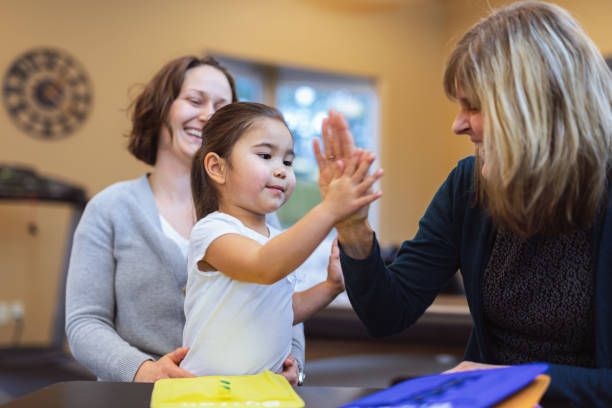Children learn words even when spoken to through masks, according to a post-Covid scientific study.

A research team from the Autonomous University of Barcelona (UAB) and the University of Grenoble Alpes - Centre National de la Recherche Scientifique (CNRS) in France has shown that children from the age of two can learn new words even when the person speaking to them has their mouth or eyes covered.
According to this study, vocabulary learning at these ages is associated with following the interlocutor's gaze and focusing on the object shown to them when the new word is pronounced, but it does not depend on selective attention to the speaker's mouth or eyes.
These results provide reassuring data on the impact of wearing a mask on children's language development, a concern raised among families and early childhood professionals during the COVID pandemic.
The study, published in the journal Developmental Psychology, is the first to show that, starting at age two, children are capable of learning new vocabulary—that is, creating associations between unfamiliar words and objects—through brief audiovisual interaction.
At the same time, it emphasizes the importance of social referencing—looking at the person speaking to seek reinforcement for their response—and attention control in learning new words.
Gaze tracking The eye-tracking and selective attention to the mouth skills that babies develop during the first year of life have been linked to the dramatic improvement in word acquisition that occurs during the second year —a phenomenon known as the 'vocabulary boost'.

Children can learn words even when their interlocutor is blindfolded. Photo: iStock
This has led some experts to propose that both attention strategies are key to infants' vocabulary development. However, until now, no cause-and-effect relationship had been found to validate this hypothesis.
"Previous studies have suggested that looking at the speaker's mouth can help children process speech better and, specifically, understand and memorize new words more easily, thanks to the visual cues provided by mouth movements. If this is the case, wearing a mask should make learning new words more difficult," explains Joan Birulés, a researcher at the Department of Basic, Developmental and Educational Psychology at the UAB and first author of the study.
To find out, the research team recorded the gaze of French children between 17 and 42 months old as they participated in a word-learning task in three situations: with the speaker's face fully visible, with their eyes covered by sunglasses, and with their mouths covered by a surgical mask.
In the task, participants were shown a screen with an interlocutor and an object on each side. The speaker uttered a monosyllabic word six times and, simultaneously, shifted their gaze to the object associated with the word on two occasions.
Sunglasses do not affect either. The results showed that children learned new words from 24 months onwards, and surprisingly, this learning was not affected by glasses or masks.
Better word learning was correlated with gaze-following behavior —moving gaze toward the object and alternating between the speaker's face and the object—across all ages and conditions.

Childhood is a fundamental stage for emotional and cognitive development. Photo: iStock
While masking the eyes or mouth altered attention patterns and caused them to focus more on the uncovered facial regions, this manipulation did not affect their ability to form new associations between the word and the object.
"The results indicate that children's optimal attention strategy is based on social understanding and visual exploration of the object, and that audiovisual information from the speaker's mouth is not an essential mechanism for rapidly establishing new associations between words and their meaning, at least in typically developing children and in rapid learning or mapping contexts," the researcher adds.
In the uncovered face situation, furthermore, children preferred to look at the speaker's eyes rather than their mouth, contrary to other previous studies in children that explore the interlocutor's face.
This leads the research team to consider that children between 1.5 and 3 years old are already able to flexibly control visual attention , adjusting selective attention between the eyes and the mouth of the interlocutor, according to the requirements of the task.
In light of the study's results, the researchers believe that an effective strategy for enhancing word learning in childhood would be to carry out a more in-depth exploration of the object in question , combined with rapid visual movements between the object and the speaker's face.
However, they do not rule out that paying attention to the speaker's mouth may be useful in situations of greater complexity in speech processing, such as in the case of children with hearing difficulties, language disorders, or those on the autism spectrum.
"In these cases, visual cues from the mouth could become essential, a question we are currently exploring in collaboration with health centers in Grenoble," Birulés explains.
Information from SINC Agency.
eltiempo





